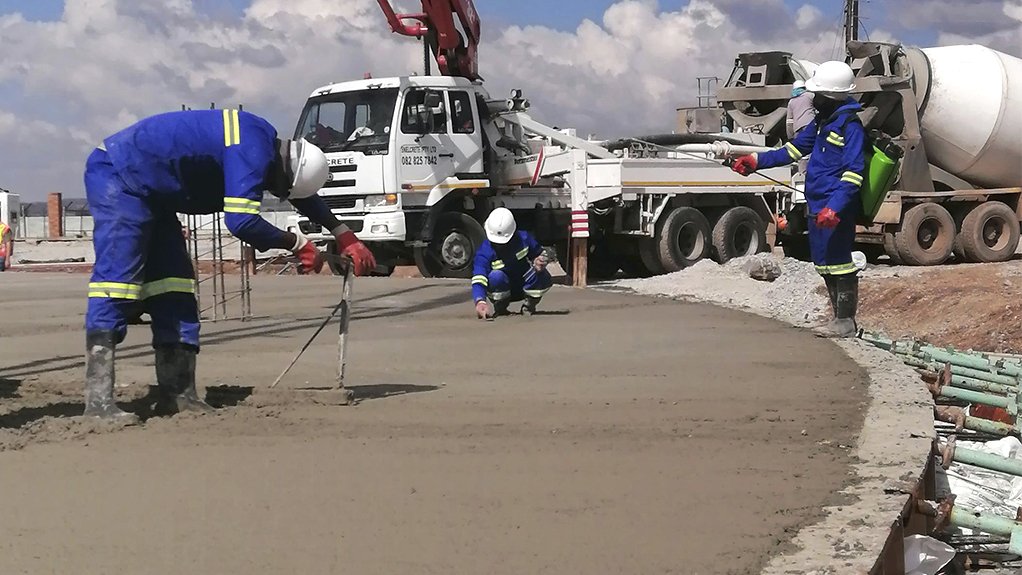Concrete admixtures help save water
Water-reducing admixtures for concrete can be used to help contractors support water conservation efforts, which are seen as particularly important in a water-scarce country such as South Africa.
Chryso highlights that its admixtures were used to reduce water and improve workability during the construction of the Vlakfontein Reservoir near Standerton in Mpumalanga. It is said to be one of the largest cylindrical post-tensioned concrete reservoirs in the world, with an inner diameter of 154 m and a heavily reinforced 11.8-m-high wall.
“One of these is CHRYSO Plast Omega 178 plasticiser which, when used in a concrete mix, permits a reduction in water content without affecting the consistency, also referred to as the workability,” says CHRYSO Southern Africa technical manager concrete business unit Patrick Flannigan. “It can also increase the slump – or flow – without affecting the water content of the mix.”
The Vlakfontein Reservoir has a groundwater drainage system constructed with three layers of 5 MPa no-fines concrete. The 8 000 m3 of no-fines concrete comprises a 50-mm-thick layer of 9.5 mm stone mix, followed by a 245 mm and 125 mm layer of 19 mm aggregate.
The company notes that its Easydrain product was introduced to these mixes to facilitate consistency and ensure the aggregate would bind mechanically and hydraulically to the cement paste. It explains that this specialised admixture fluidises the concrete, assists with a homogenous mix and improves curing to reduce the chance of cracking, to ensure that the bonded aggregates will not loosen, once dried. An additional drainage layer of around 2 200 m3 of no-fines concrete will be poured around the reservoir.
Once the no-fines concrete was completed, a layer of 200 mm 35 MPa concrete was pumped in 13 pours of approximately 250 m3 each. This mix included CHRYSO Serenis, a shrinkage reducing admixture. This, together with CHRYSO Omega 178 superplasticiser, is designed to reduce water and assist with workability.
CHRYSO CWA 10 crystalline waterproofing agent is said to provide integral waterproofing and reduce permeability in the concrete. The crystals prevent water penetration and protect the concrete against corrosive groundwater and chemicals.
Its water-reducing admixtures were also used in the Khutsong Reservoir near Carletonville in Gauteng. Due to the danger of sinkholes in this region and the possibility of ground movement, the reservoir is the first to be constructed with a pre-tensioned concrete floor.
The 1 267 m3 concrete floor used pumped mixes at 35 MPa at a thickness of 450 mm and the concrete mix included CHRYSO ZA 1559, a new generation, multi-dose water-reducing plasticiser.
Flannigan notes that it improves the cohesion and lowers the viscosity of a concrete mix. This results in an improved homogeneity and compaction, allowing for superior off-shutter finishes. With less need to add extra water, CHRYSO ZA 1559 reduces the permeability of concrete, thereby improving its durability.
“The product may be used in mixes extended with limestone or commonly used supplementary cementing materials like ground granulated blast furnace slag, fly ash and silica fume,” he says. “At the same time, it does not undermine the early age strength of concrete. In fact, in certain cases, it may be used to improve it.”
The product has applications in readymix concrete and mechanically mixed site concrete, as well as conventionally placed, pumped and highly reinforced concrete. It conforms to the requirements of SANS 50934-2 (EN 934-2) standards, which are approximate equivalents of ASTM C494 Type A.
Water evaporation was said to be successfully controlled with CHRYSO Profilm 19 evaporation reducer, while shrinkage of the reservoir floor was reduced using CHRYSO Serenis shrinkage reducing agent. A minimum of 180 ℓ of water per cubic metre had to be used and fly ash was added as the heat of hydration had to be controlled owing to the mass pour. The end strength did not exceed 45 MPa.
Comments
Press Office
Announcements
What's On
Subscribe to improve your user experience...
Option 1 (equivalent of R125 a month):
Receive a weekly copy of Creamer Media's Engineering News & Mining Weekly magazine
(print copy for those in South Africa and e-magazine for those outside of South Africa)
Receive daily email newsletters
Access to full search results
Access archive of magazine back copies
Access to Projects in Progress
Access to ONE Research Report of your choice in PDF format
Option 2 (equivalent of R375 a month):
All benefits from Option 1
PLUS
Access to Creamer Media's Research Channel Africa for ALL Research Reports, in PDF format, on various industrial and mining sectors
including Electricity; Water; Energy Transition; Hydrogen; Roads, Rail and Ports; Coal; Gold; Platinum; Battery Metals; etc.
Already a subscriber?
Forgotten your password?
Receive weekly copy of Creamer Media's Engineering News & Mining Weekly magazine (print copy for those in South Africa and e-magazine for those outside of South Africa)
➕
Recieve daily email newsletters
➕
Access to full search results
➕
Access archive of magazine back copies
➕
Access to Projects in Progress
➕
Access to ONE Research Report of your choice in PDF format
RESEARCH CHANNEL AFRICA
R4500 (equivalent of R375 a month)
SUBSCRIBEAll benefits from Option 1
➕
Access to Creamer Media's Research Channel Africa for ALL Research Reports on various industrial and mining sectors, in PDF format, including on:
Electricity
➕
Water
➕
Energy Transition
➕
Hydrogen
➕
Roads, Rail and Ports
➕
Coal
➕
Gold
➕
Platinum
➕
Battery Metals
➕
etc.
Receive all benefits from Option 1 or Option 2 delivered to numerous people at your company
➕
Multiple User names and Passwords for simultaneous log-ins
➕
Intranet integration access to all in your organisation





















